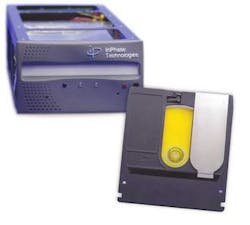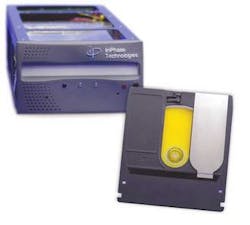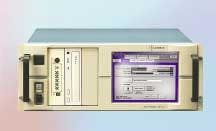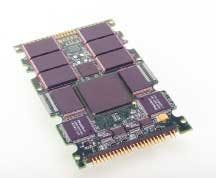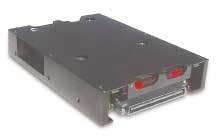Military designers continue to favor hard drives for data storage because of their density and cost efficiency, but new technologies are on the way, including holographic optical storage and flash devices.
Designers of military platforms are crying out for greater storage capacity for applications such as surveillance sensors on unmanned aerial vehicles and telemetry recorders in naval missile launches.
They have many choices, ranging from spinning hard drives to solid-state flash with options like holographic and optical media just around the corner
The market consensus is that for most jobs, hard drives offer the greatest storage density and cost efficiency. Driven by demand in the consumer market, researchers are announcing frequent technology advances in hard drives and interfaces, with improvements in cost, capacity, and data interfaces.
Here comes holographic memory
Engineers have long promised that holographic memory would break all records for storage density, because it captures data throughout the volume of its medium. Conventional media store data only on the surface, such as optical bits on a compact disk or magnetic bits on a disk drive.
In October, researchers at InPhase Technologies of Longmont, Colo., announced they had built the first functional prototype of a holographic memory device. They plan to release the first disks by December 2005 for beta testing, and begin volume production in 2006.
The new medium is a 130-millimeter disk made of photopolymer, sandwiched in a plastic cartridge with a shutter unit, says Liz Murphy, InPhase vice president of marketing.
To the human eye, the material is translucent plastic. But the read/write drive converts data bits to an optical signal, then burns them into the plastic with a blue laser. This process stores each page as a checkerboard-type pattern, and etches each new page at a slightly different angle within the same medium. A laser interface writes 1.3 million bits at a time, then repeats the process, storing as many as 100 such “pages” in one location.
A holographic storage drive costs about as much as a high-end tape drive and with similar performance and capacity; it can store 200 gigabytes with 20 megabytes per second transfer rate. The difference is that holographic memory offers random access and long archival life, she says. Researchers have rated the new material for a 50-year archival life - much longer than tape or hard disk.
The first users of holographic storage will probably be librarians who need to store rich media such as film and video. Also, leaders at the U.S. National Geospatial Intelligence Agency have been funding InPhase research for years, in a search for better ways to store satellite imagery.
InPhase engineers are already working on improvements for the second generation. By July 2007, the next version will be rewritable (first-generation disks can be written just once). They are also studying ways to harden the disks for rugged applications, and to encrypt data with a hardware phase mask. Their long-term goal is to release a 1.6-terabyte disk by 2010, Murphy says.
Optical storage looks better every day
Another optical storage technology now hitting the market is Blu-ray, an optical disk format developed to record, rewrite, and play back high-definition television (HDTV). A Blu-ray Disk (BD) can record more than two hours of HDTV or more than 13 hours of standard definition television on a 25 gigabyte disk.
Designers are seeking ways to layer two disks to hold up to 50 gigabytes of data, or layer four disks to store 100 gigabytes. Blu-ray readers transfer data at 36 megabits per second. And like any optical disk, Blu-ray uses its random-access ability to simultaneously record and play back video.
The technology was jointly developed by engineers at 11 consumer electronics companies: Hitachi Ltd., LG Electronics Inc., Matsushita Electric Industrial Co. Ltd., Mitsubishi Electric Corp., Pioneer Corp., Royal Philips Electronics, Samsung Electronics Co. Ltd., Sharp Corp., Sony Corp., TDK Corp., and Thomson Multimedia.
It relies on the properties of a short-wavelength blue laser, as opposed to the standard red laser used by current optical-disk technologies such as DVD. The 405-nanometer blue laser enables engineers to read and write data with more precision than a 650-nanometer red laser, and pack more data on the same size disk. For more information, see www.blue-ray.com.
Hard disks store the densest data
Military memory suppliers say they rely on technology from the consumer electronics market as they ruggedize storage devices. They have seen three recent improvements in consumer off-the-shelf (COTS) storage: smaller form factor, larger capacity, and less power draw, says Rod Copeland, director of operations for Mountain Optech Inc., in Longmont, Colo.
Storage designers use the shorthand term SWAP to refer to size, weight, and power. The SWAP improvement is most obvious in the actual size of disks. The market has always survived on 3.5-inch disks for servers and 2.5-inch disks for laptops. But manufacturers have now released 1.8-inch disks with the same memory capacity as the larger disks, as much as to 60 gigabytes per platter.
Another recent improvement is a wider choice of host interfaces. Until now, users have been forced to choose between IDE (Integrated Drive Electronics, also called Advanced Technology Attachment (ATA)), SCSI (Small Computer System Interface), and Fibre Channel. But many new products use Gigabit Ethernet, Serial ATA, and even USB (Universal Serial Bus).
Together, those improvements have allowed Mountain Optech to win new contracts for rugged storage. In September, the company shipped eight ruggedized Fibre Channel hard disk drives to Sandia National Laboratories in Albuquerque, N.M. Researchers will use them to collect data from a Tactical Interferometric Synthetic Aperture Radar (TacIFSAR) flying aboard a Predator-B unmanned aerial vehicle.
The system stores 1.2 terabytes today, and Mountain Optech will double that capacity by July 2005, using a set of 300-gigabyte drives from Seagate Technology in Scotts Valley, Calif.
In another recent win, researchers at NASA’s Jet Propulsion Laboratory in Pasadena, Calif., and at MIT’s Lincoln Labs in Lincoln, Mass., each bought three of Mountain Optech’s Monarch Systems. The new platform is a rugged, 19-inch SCSI rack-mount with eight sealed drives.
The rapid growth of hard-disk-drive technology has stolen market share from other technologies, including solid-state and magneto optical.
“Solid-state is never going to catch up to hard drives,” Copeland says. “There’s a 10 times price penalty, so customers will use them only if the environment is harsh enough. And hard-drive manufacturers are moving faster in capacity than solid-state. You can buy a ruggedized, 150-gigabyte hard drive for $5,000 or $6,000, but you would pay $100,000 for the same thing in solid-state.”
Likewise, storage capacity in magneto optical drives is only now rising from 5.2 or 9.1 gigabytes to 20 to 30 gigabytes in the next generation. The strength of a magneto optical device is in archiving because it can store data for as long as 40 years. That is far longer than hard drives, and more secure than tape, Copeland said. That makes it good for applications aboard Aegis ships, where technicians monitor missile launches and store telemetry data.
New interfaces speed storage
A typical desktop PC uses an IDE-drive interface, based on parallel ATA technology. But in the past 12 months, a serial version of ATA, called SATA, has hit production. SATA has quickly become popular with engineers because it brings high-performance, high-capacity data storage at a low price.
“SATA allows you to use very inexpensive disk drives, just a third to a half the cost of comparable Fibre Channel or Ultra 320 SCSI drives. That’s pretty compelling to a lot of folks,” says Amos Deacon III, vice president of marketing and sales for Phoenix International in Orange, Calif. “We can put together a SATA RAID system with two-terabyte capacity for under $5,000.”
Still, military designers are hesitant to use SATA in mission-critical applications. The mean time between failures (MTBF) is just 300,000 to 400,000 hours for SATA, compared to 1.4 million hours for SCSI, he said.
That is because the electromechanical portions of a SATA disk are more susceptible to vibration than Fibre Channel or SCSI disks. So engineers choose SATA for applications in creative media arts, such as film and video editing, which need vast amounts of data storage that can reside in a quiet office environment.
Likewise, engineers have created a new interface based on serial SCSI instead of the current parallel SCSI. In general, a serial interface uses fewer wires, is less susceptible to external electric noise, is easier to connect, operates faster, and can connect devices farther apart, Deacon says.
A parallel SCSI interface can connect devices about three meters apart, while the new serial SCSI interface can stretch between devices located 10 meters apart, he says. By comparison, Fibre Channel can reach even farther, making it good for campus environments and storage-area networks (SANs).
But SAS will remain competitive with Fibre Channel in small-area jobs, simply because engineers are accustomed to the technology, Deacon says. “Fibre Channel disks came out seven or eight years ago, and were heralded as the death of SCSI, but today, 90 percent of enterprise class drives are still SCSI.”
Drive manufacturers such as Seagate are planning to release SAS storage devices by the end of 2004, he says. For more information, see the SCSI Trade Association., www.scsita.org.
Hard disks keep getting denser
Flash memory has its place for applications like avionics with its constrained space and harsh environment, but the storage industry is producing much more innovation in hard-drive technology.
“Almost as frequently as disk-drive manufacturers roll out a drive, they are sunsetting it for the next generation,” says Tom Skrobasz, vice president of business development for Conduant Corp. of Longmont, Colo. “We are seeing up to 400-gigabyte disks today whereas a year ago we were talking about 150. And there’s no threat to that growth on the five-year horizon.”
Another change in disk technology is networking. Engineers are boosting storage capacity not only on single disks, but also on collections of as many as 16 disks.
In turn, the networked storage trend has fueled the change from parallel to serial ATA drive interfaces, Skrobasz says. Engineers building networked storage systems with parallel ATA interfaces are limited by their connection to a PCI or Compact PCI board, he says. The new SATA connectors are less than half the size, and offer better flexibility, moving from a master/slave architecture to shared bus bandwidth.
Accordingly, Conduant designers have released the StreamStor PXI 808 data-acquisition system and the Big River DM4 data module, both designed for applications in test and measurement. And by the end of 2004, they plan to release the Big River LTX recorder, a “laptop recorder” for mobile applications.
Rugged disk drives are not just for military applications. Astronomers are major storage customers, recording massive amounts of data in their laboratories perched alongside their mountaintop antennas. That can pose a challenge to hard drives because the thin atmosphere steals the air between the spinning platter and the delicate head. Most commercial disks are rated only to 10,000 feet, and the disk is instantly ruined if it touches the head. So engineers at Conduant work with Mountain Optech to ruggedize their disks for altitude as well as shock, heating, and cooling.
The disks must have capacity, as well. Astronomers using VLBI (very large baseline interferometry) record their data at nearly 2-gigabits-per-second data rate today, and are planning to operate at 4 gigabits in the next generation.
Another demand for storage capacity comes from the net-centric battlefield, in both INET, the integrated network of enabled telemetry, and in signal intelligence, Skrobasz says. Battlefield sensors collect massive amounts of data - from unmanned aerial vehicles (UAVs) to ground sensors - so defense planners rely on storage to handle it all. That is particularly important at the fusion point, where a single information dominance center (IDC) collects data from every source, then scrubs, filters, and distributes it back to soldiers in the battlefield.
By the same token, every object in the net-centric battlefield has its own Internet node. That represents a new paradigm of war planning, where telemetry changes from a point-to-point transfer to a wide area network that covers an entire area with a radio-frequency cloud, to reach every node, says Randy Burgess, Conduant’s director of marketing and communication.
To cope with such massive databases, storage technology must be distributed, not local. The key to that capability is 10 Gigabit Ethernet, which is swiftly growing from just an information technology tool to an infrastructure on ships and aircraft.
Users demand immediate playback
Military users push their storage equipment to its limits. They need to record vast amounts of data, read and share it immediately, and store it in rough environmental conditions. And now they are making new demands - trends for disks and RAID-based storage include lower prices, larger and faster disks, and net-centric architectures that can handle data anywhere, whether it is acquiring, distributing, or archiving.
Customers can meet those challenges with two new products, the Silver Phoenix and Model 800, says Chuck Buschbach, director of product management for Sypris Data Systems, in San Dimas, Calif. Both use commercial hard drives from manufacturers like Seagate, he says. The Silver Phoenix uses a Fibre Channel backbone to acquire multiple data types with an array of drives. The largest customers can increase throughput into the multiple-gigabit range by adding more disk arrays.
The Model 800 is based on the PCI bus, so it is a more modular, COTS-based approach, for customer who need performance only up to one gigabit per second. Applications for the Model 800 could include intelligence operations on a Rivet Joint or P-3 aircraft, or weapons testing in a mobile trailer. These users could also plug in solid-state memory modules with a SCSI interface, but most would choose the lower cost and higher capacity of disk drives, Buschbach says.
Customers on weapons-testing ranges and space-launch pads demand another capability: they need confidence monitoring and immediate playback to ensure they are recording each event.
“In real-time data acquisition, you can’t really say ‘Bring that missile back; I need to fire it again,’” says Buschbach.
COTS components in demand
The amount of data people need to store for military and aerospace applications is growing exponentially. In NATO bases and U.S. Naval Air Stations around the world, air traffic controllers record a vast amount of data as they do their jobs. NATO is the North Atlantic Treaty Organization.
“The idea is to recreate exactly what was going on during major events,” says Doug Crawford, product manager at Formation Inc. in Moorestown, N.J. “They want to see what the controller was seeing, read what he saw on the radar screen, and hear what he said on the radio.”
Those troops record all the data on Formation’s Advanced Integrated Recorder (AIR), a set of networkable servers with as much as 1.5 terabytes of disk storage apiece.
The device is called “integrated” because it can synchronously record voice, data, radar, and other signals up to 660 channels. Then users can read the data within seconds of recording it, even if they are sitting in Washington, D.C., and watching events in Coronado Island, Wash., Crawford said.
“It took us days to piece intelligence together to recreate what happened in the attack on the USS Cole,” says Formation president Nim Evat, speaking of the October 2000 attack on a U.S. Navy vessel in Yemen that killed 17 sailors. “We could have done it much faster with this system, because we’re able to store terabytes of data in three or four U of rack space.”
Fast performance is not enough to do the job; the devices must have enormous capacity, too. The latest generation of Advanced Integrated Recorders can fit 30 or 60 days of data on a hard drive, even as the air traffic controllers are generating data 24 hours per day, seven days per week, he said.
New technologies like solid-state flash memory just cannot match that high storage density and low price.
“We’re seeing a move from custom to COTS-based systems,” Evat says. “As disk systems become more able to handle tough environments, you will see a big investment in cost and capacity for military and aerospace, because COTS hard-drive components are getting better.”
Engineers at Formation buy commercial disk drives from manufacturers like Fuji, Hitachi, and IBM, he says. The industry creates new products every year, so they shop for the best disks, then build ruggedized containers to protect them. The company’s newest products are the ToughDisk 7200 (selling now) and ToughDisk 3500 (due for release by the end of 2004).
The ToughDisk 7200 is a ruggedized, 320-gigabyte system with four disks, weighing less than four pounds. A smaller version uses two disks for 160 megabytes of storage. Both offer hot-pluggable, high-bandwidth capabilities for surveillance and reconnaissance jobs, with built-in RAID capability.
And the ToughDisk 3500 is a one-pound, ruggedized, 80-gigabyte system. It is designed as a drop-in replacement for a standard 3.5-inch disk drive, such as the servers often loaded in the back of a HMMWV. This technology competes with more rugged flash memory, while selling at one-tenth the cost, Crawford says.
Storage cost keeps dropping
There are five major limitations to hard-drive technology for military applications: environmental limits, large size, high power consumption, susceptibility to mechanical failures, and lack of data protection. Yet two factors ensure that engineers keep using them: hard drives are the industry standard so designers are accustomed to the technology and hard drives are cheaper than any other option, says Patrick Wilkinson, managing director of marketing for SimpleTech, Santa Ana, Calif.
Technology is pushing capacity up and price down for storage media, says Steve Gudknecht, marketing manager for storage products at ACT/Technico, in Ivyland, Pa. Those trends are moving particularly fast for flash memory, which is driven by applications in consumer electronics such as digital cameras and iPod music players. However, integrators do not place commercial products directly into military devices, says Valerie Andrew, strategic marketing manager at ACT/Technico.
Flash is still expensive, but it is winning more converts in its “sweet spot” of 16 to 32 gigabytes, Wilkinson says. Its price is dropping as flash memory is used more in consumer electronics, such as digital cameras. And companies are jumping into the market - until recently, Samsung and Toshiba were the only major manufacturers of flash memory. Today there are five more suppliers: Renesas Technology in San Jose, Calif., Hynix Semiconductor in Seoul, South Korea, Infineon Technologies in Munich, Germany, STMicroelectronics in Geneva, Switzerland, and Micron Technology in Boise, Idaho.
“There is a big distinction between commercial and industrial-grade flash,” Gudknecht says. “You can buy a gigabyte of flash for $80 at the local Office Max or Staples, but it is more expensive for industrial products because we run them through testing and qualification to raise the mean time between failure, warrantees, and resistance to shock, vibration, and temperature.”
Only a few companies, including SanDisk of Sunnyvale, Calif., and Swissbit of Port Chester, N.Y., manufacture ruggedized flash, Gudknecht says. Ruggedized hard drives also have a narrow market, with manufacturers such as Hitachi and Fujitsu. One of the best products in that sector is Hitachi’s Endurastar, a 20-gigabyte, 2.5-inch hard drive, rated for temperatures from -45 to 80 degrees Celsius, with good capacity for shock and vibration, Gudknecht adds.
ACT/Technico makes a line of both VME-based and Compact PCI-based disk modules, using a combination of 2.5- and 3.5-inch hard disks, optical compact disks or DVDs, and compact flash boards.
Despite its recent progress, flash memory is still much more expensive than hard drives. Designers at ACT/Technico can buy a 20-gigabyte, ruggedized hard drive for $212, compared to about $7,000 for the same capacity in temperature-protected compact flash, he says.
Another way to address the five weaknesses of hard drives is Zeus, an UltraDMA solid-state drive from SimpleTech. It is designed for storing voice and data on the F-18 jet fighter and Army helicopters, as well as nonmilitary tasks such as data capture for industrial systems or in-flight entertainment for commercial aviation.
Another new product hitting the market is the E-Disk 3S320D, an Ultra320 SCSI flash drive from BiTMICRO, Fremont, Calif. It offers capacity of 155 gigabytes in a 3.5-inch form factor, with burst-rate performance of 320 megabits per second.
The ruggedness of Flash
Engineers at General Electric recently had to build memory into a device for pipeline inspection, one of the roughest jobs on Earth. They chose a serial ATA flash drive from Adtron Corp., in Phoenix. The drive was a good match for the job because flash memory is inherently rugged, with smaller demands on physical space than a ruggedized hard drive, says Adtron’s chief executive officer, Bob Benkendorf. The latest flash drives boost performance even further with a serial ATA interface. Compared to predecessors IDE and parallel ATA, serial ATA (SATA) offers an easier cabling infrastructure and enables hot-swappable drives.
Aircraft have used serial buses for years to handle control, but not bulk data. That is starting to change, as avionics designers use the technology to handle data over new interfaces such as 10 Gigabit Ethernet and Fibre Channel, says Alan Fitzgerald, Adtron’s president and chief technology officer.
Gigabit Ethernet is popular with telecommunications engineers because it lets them store data in networks, not just single disks. That way, designers can store information anywhere in a building or vehicle, and better survive equipment failures. Those attributes have also sparked avionics engineers to start developing an airborne protocol for Gigabit Ethernet, Benkendorf says.
“The only way to achieve five-nines performance is to provide redundancy with active standby. That method is widely deployed today in telecom, and will soon make its way into commercial and military aircraft. We’re working on it with Airbus now,” he says. Five-nines performance indicates a system will work 99.999 percent of the time.
Some engineers argue that the best way to ensure the survivability of data is the inherent ruggedness of solid-state flash because it has no moving parts, he said. Despite its high cost, flash is growing fast in terms of capacity and performance. That opens up new applications, like mission recording, countermeasures, and intelligence, surveillance, and reconnaissance.
Since this time last year, flash performance has improved two to three times, while capacity has risen from 30 gigabytes to 156 gigabytes, and price has dropped from “very expensive” to “less so,” he says.
Adtron is shipping flash devices with 128-gigabyte capacity with 75-megabyte-per-second performance for 40 cents per megabyte. Next-generation products are expected to offer 300-gigabyte capacity with 120-megabytes-per-second performance for 20 cents per megabyte.
As military planners migrate to a net-centric battlespace that relies on mapping and radar imaging, flash memory technology will become more important, Fitzgerald says.
And data demands are rising fast. “A year ago I would have said to replace disk drives we would need capacity of 10 to 20 gigabytes and performance of 15 to 20 megabytes per second. And you would need to be storing high-value data to be worth the price of flash. But now, user requirements are 30 to 250 gigabytes of storage, and 50 to 100 megabytes per second in performance. So the spectrum has shifted.”RAID keeps data secure
Performance is not the only metric for storage systems - users also demand data security. That is where RAID (redundant array of independent disks) comes in.
Engineers can choose from several varieties of RAID, says Amos Deacon III, vice president of marketing and sales for Phoenix International in Orange, Calif. “It all comes down to economics; how much is your data worth to you?”
RAID Level 0 is striping, the technique of writing data across multiple disks. Instead of one head writing data to a single disk, there are many writing at once, so they work much faster. The downside is that there is no data redundancy, so if one disk fails, data from every disk is lost. This method is used most often in media applications like digital editing.
RAID Level 1 is mirroring, a method of duplicating data. This system uses a minimum of two disks, which are mirror images of each other, so they provide total data redundancy. The downside is that it is expensive, since a user must buy two terabytes of disk space to store one terabyte of data.
RAID Levels 3 and 5 is parity, a technique of duplicating data in less space. As it writes a record, this system writes a matching parity bit. If a drive later fails, the system can use algorithms to recreate the missing data. This method is less expensive than mirroring.
Until recently, most users chose Level 3 for jobs with constant data flow, like streaming video, and chose Level 5 for jobs with transactions and databases. But today, Level 5 is the most popular RAID method for all applications.
Destroying precious data
Storing data in a battlefield raises another design challenge - How do you eliminate data if it falls into enemy hands? Military designers cite three forms of data security: clear, sanitize, and destroy.
Clearing data is a method of simply erasing it from the media, a process than can take hours on a hard drive, and 10 to 20 seconds on flash circuits.
Sanitizing data is a more thorough method, because technicians can reconstruct cleared data in a laboratory. This method demands that a user over-writes the medium with random bits up to three times.
Finally, the most reliable method is physical destruction. When troops need to instantly protect a hard drive, they will swing an axe or hammer through the disk, or shoot it with their service pistol.
“Envision a disabled Apache helicopter 100 feet off the ground, and falling fast,” says Alan Fitzgerald, president and chief technology officer of Adtron in Phoenix. “How long until it hits the ground? You’ve got to destroy your data first.”
Another special demand for battlefield data storage is write-protect, to ensure that a user cannot mistakenly erase his data by recording new data on top of it.
“There are 100 or 200 servers aboard an Aegis-class ship,” he says. “The most common configuration is with a boot disk in flash, and the file and application servers on a hard drive. Each server runs a high-reliability [operating system] like Linux. In that scenario, write-protection protects the kernel from being corrupted.”
Designers at Adtron make an external bolt-on device that serves as a physical write-protect, attached between the boot and the storage device.
One of the simplest solutions is removable memory. So in December, ACT/Technico in Ivyland, Pa., will introduce a removable PMC-shaped solution with either 2.5-inch rotating drive or solid-state board.
Until now, users bought hot-swappable memory for maintenance reasons, so they could easily replace failed drives. Today, designers are asking for removable memory so troops can quickly declassify a computer or vehicle if they are forced to abandon it in the field.
“If you need to make a quick exit of your vehicle without removable media, then you can take out your axe, or do an hours-long erase process. Even then, an erased disk can be reconstructed in a lab,” says Steve Gudknecht, marketing manager for storage products at ACT/Technico. “Compact flash is easier to erase: SanDisk has a method for almost instantaneously destroying the card; it sends an overcurrent through the board to burn the links in the chip.”
Military designers are also demanding storage redundancy, both for data protection and high availability.
ACT/Technico serves this demand with a RAID storage product using a Compact PCI-based single blade with two 2.5-inch drives, so the user can either mirror or stripe his data. If he uses two units, he can mirror the entire blade. That product is available now in 160 gigabytes per blade, for applications in a mobile command room, ground control station, or shipboard. The company plans a version with 240 gigabytes per blade in the next generation, Gudknecht says.
